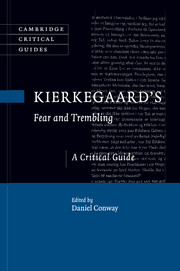Book contents
- Frontmatter
- Contents
- List of Contributors
- Acknowledgments
- List of Abbreviations
- Introduction
- Chapter 1 Homing in on Fear and Trembling
- Chapter 2 Fear and Trembling’s “Attunement” as midrash
- Chapter 3 Johannes de silentio’s dilemma
- Chapter 4 Can an admirer of silentio’s Abraham consistently believe that child sacrifice is forbidden?
- Chapter 5 Eschatological faith and repetition: Kierkegaard’s Abraham and Job
- Chapter 6 The existential dimension of faith
- Chapter 7 Learning to hope: the role of hope in Fear and Trembling
- Chapter 8 On being moved and hearing voices: passion and religious experience in Fear and Trembling
- Chapter 9 Birth, love, and hybridity: Fear and Trembling and the Symposium
- Chapter 10 Narrative unity and the moment of crisis in Fear and Trembling
- Chapter 11 Particularity and ethical attunement: situating Problema III
- Chapter 12 ‘He speaks in tongues’: hearing the truth of Abraham’s words of faith
- Chapter 13 Why Moriah?: weaning and the trauma of transcendence in Kierkegaard’s Fear and Trembling
- Bibliography
- Index
- References
Bibliography
Published online by Cambridge University Press: 05 February 2015
- Frontmatter
- Contents
- List of Contributors
- Acknowledgments
- List of Abbreviations
- Introduction
- Chapter 1 Homing in on Fear and Trembling
- Chapter 2 Fear and Trembling’s “Attunement” as midrash
- Chapter 3 Johannes de silentio’s dilemma
- Chapter 4 Can an admirer of silentio’s Abraham consistently believe that child sacrifice is forbidden?
- Chapter 5 Eschatological faith and repetition: Kierkegaard’s Abraham and Job
- Chapter 6 The existential dimension of faith
- Chapter 7 Learning to hope: the role of hope in Fear and Trembling
- Chapter 8 On being moved and hearing voices: passion and religious experience in Fear and Trembling
- Chapter 9 Birth, love, and hybridity: Fear and Trembling and the Symposium
- Chapter 10 Narrative unity and the moment of crisis in Fear and Trembling
- Chapter 11 Particularity and ethical attunement: situating Problema III
- Chapter 12 ‘He speaks in tongues’: hearing the truth of Abraham’s words of faith
- Chapter 13 Why Moriah?: weaning and the trauma of transcendence in Kierkegaard’s Fear and Trembling
- Bibliography
- Index
- References
- Type
- Chapter
- Information
- Kierkegaard's Fear and TremblingA Critical Guide, pp. 263 - 272Publisher: Cambridge University PressPrint publication year: 2015



